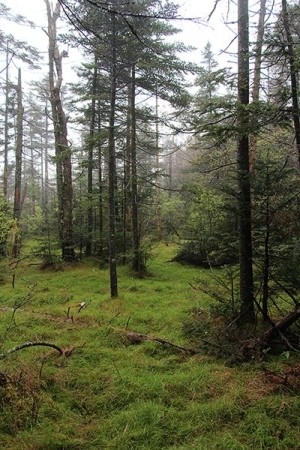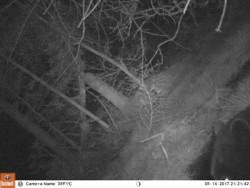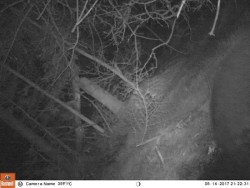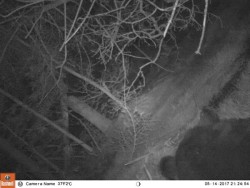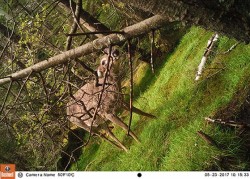We ended our last game camera entry this way: For our next installment, we’ll set a camera up in some edge habitat on the top of a mountain in a wilderness area. We wonder what the ratio of day-to-night shots will be in a place that’s mostly unvisited by humans. No red flags went off in our mind at the time, though looking back we’re reminded that cliffhangers are almost always a dumb idea if you can’t script the outcome.
We hiked into the Green Mountain National Forest to a place about five miles from any maintained road. It was an unmanaged forest, so the edge habitat we focused on was an out-of-place-seeming fen in a sea of spruce-fir. There was some sphagnum moss on the ground, but the understory was mostly sedge; you could see where the animals were working the inside edge to and from a pocket of open water. We set up the camera at the edge of the open water, pointing directly down the sedge-trampled trail. There was a long window in which to capture anything that was coming and going.
A month later we returned, and immediately noticed something was amiss. The camera had been disturbed and was pointing almost straight down. “Oh I hope we at least got footage of the disturbance,” we thought, but it wasn’t meant to be. Two days after we’d set the camera up – two days – a large black bear came in, at night, from behind, and knocked the camera out of whack.
We got a sequence of 24 shots during the encounter, over the course of four minutes, but the photos gave no real sense of what was happening. Afterwards, the camera sat for 16 days pointed at the ground. The only sign of life we got was one curious deer, who, wondering where on earth this strange box came from, somehow managed to insert herself into the askance camera frame.
For our next installment, we’ll set up a game camera on a pink moccasin lady's slipper patch to try to catch the culprit that’s eating them. And, yes, we learned our lesson. We already have the footage in hand, and it’s really cool.


